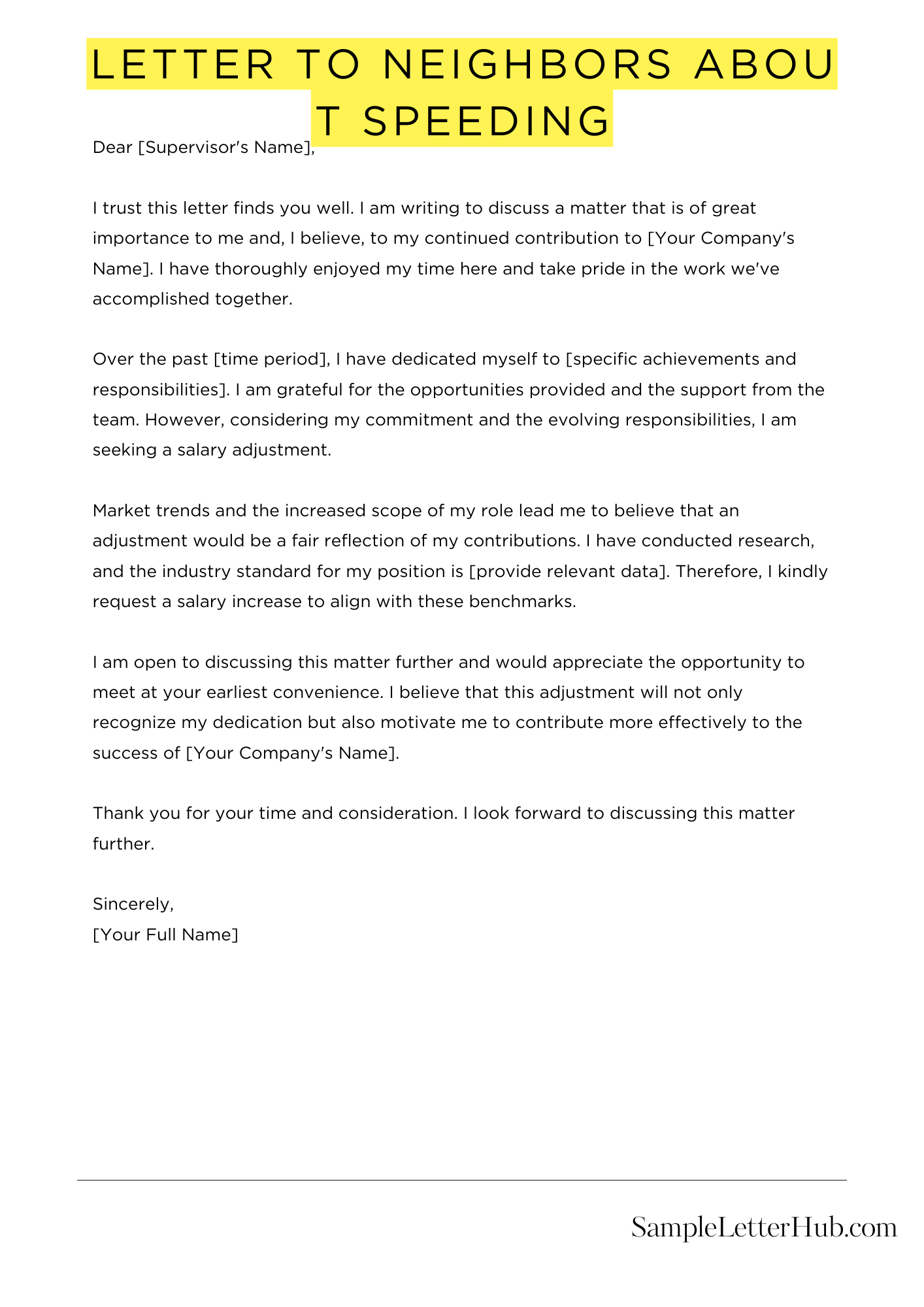Letter To Neighbors About Speeding is a letter written to neighbors to address the issue of speeding in the neighborhood. The purpose of this letter is to raise awareness about the problem, express concerns, and request cooperation in finding a solution.
In this article, we will share templates, examples, and samples of Letter To Neighbors About Speeding. These samples are designed to provide you with a starting point and help you craft a clear and effective letter that addresses the speeding issue in your neighborhood.
Notice to Neighbors Regarding Excessive Speeding
Dear Neighbors,
I am writing to express my concern about the excessive speeding that has become a problem in our neighborhood. I have noticed a significant increase in the number of vehicles traveling at unsafe speeds, posing a danger to pedestrians, cyclists, and other motorists.
The speed limit in our neighborhood is 25 miles per hour. This limit is in place for a reason: to ensure the safety of all who live, work, and visit our community. When drivers exceed the speed limit, they put everyone at risk.
Excessive speeding can have serious consequences. It increases the likelihood of accidents, which can result in injuries or even fatalities. It also creates noise pollution, making our neighborhood less peaceful and enjoyable.
I urge all neighbors to be mindful of their speed and to adhere to the posted limit. By working together, we can create a safer and more pleasant environment for everyone.
If you witness excessive speeding, please report it to the local authorities. Your cooperation is essential in addressing this issue.
Thank you for your attention to this important matter.
Sincerely,
[Your Name]

How to Write a Letter to Neighbors About Speeding
Excessive speeding in residential areas poses a significant threat to the safety and well-being of residents. If you find yourself concerned about speeding vehicles in your neighborhood, writing a letter to your neighbors can be an effective way to raise awareness and address the issue.
Gather Evidence
Before drafting your letter, gather evidence to support your concerns. Note down the frequency and time of day when speeding occurs, as well as any specific incidents or near-misses you have witnessed.
Be Polite and Respectful
It is important to approach your neighbors with politeness and respect. Begin your letter with a friendly greeting and express your appreciation for their time. Avoid accusatory language and focus on the safety concerns you have observed.
Provide Specific Examples
Provide specific examples of speeding incidents or near-misses to illustrate the problem. Include details such as the date, time, and location where these incidents occurred.
Suggest Solutions
Offer constructive suggestions for addressing the speeding issue. This could include requesting increased police patrols, installing speed bumps or signs, or organizing a neighborhood watch program.
Seek Collaboration
Emphasize the importance of working together as a community to address the problem. Invite your neighbors to join you in advocating for safer streets and suggest ways they can contribute, such as reporting speeding vehicles or volunteering for neighborhood patrols.
Follow Up
After sending your letter, follow up with your neighbors to gauge their response. If there is interest in addressing the issue, consider organizing a neighborhood meeting to discuss potential solutions further.
FAQs about Letter To Neighbors About Speeding
What should I include in a letter to my neighbors about speeding?
When writing a letter to your neighbors about speeding, it is important to include the following information:
- A clear and concise statement of the problem, including specific examples of speeding incidents.
- A request for your neighbors to slow down and obey the speed limit.
- A list of the potential consequences of speeding, such as accidents, injuries, and property damage.
- A suggestion for a solution, such as increased police enforcement or the installation of speed bumps.
- A call to action, asking your neighbors to join you in working to reduce speeding in your neighborhood.
How can I write a letter to my neighbors about speeding that is both polite and effective?
When writing a letter to your neighbors about speeding, it is important to be polite and respectful, even if you are frustrated by their behavior. Here are some tips for writing an effective letter:
- Start by thanking your neighbors for their time and attention.
- State your concerns about speeding in a clear and concise way.
- Provide specific examples of speeding incidents, if possible.
- Explain the potential consequences of speeding, such as accidents, injuries, and property damage.
- Suggest a solution to the problem, such as increased police enforcement or the installation of speed bumps.
- End by asking your neighbors to join you in working to reduce speeding in your neighborhood.
What should I do if my neighbors do not respond to my letter about speeding?
If your neighbors do not respond to your letter about speeding, there are a few things you can do:
- Follow up with a phone call or email.
- Talk to your neighbors in person.
- Contact your local police department or homeowners association.
- Organize a neighborhood meeting to discuss the issue.
What are some other ways to reduce speeding in my neighborhood?
In addition to writing a letter to your neighbors, there are a number of other things you can do to reduce speeding in your neighborhood:
- Contact your local police department and ask for increased enforcement.
- Request the installation of speed bumps or other traffic calming measures.
- Organize a neighborhood watch program to monitor speeding and report violators to the police.
- Educate your neighbors about the dangers of speeding and the importance of obeying the speed limit.
What are the legal consequences of speeding?
The legal consequences of speeding vary depending on the jurisdiction, but they can include:
- Fines
- Jail time
- Loss of license
- Increased insurance rates

